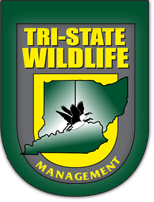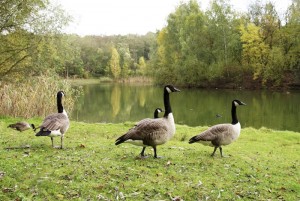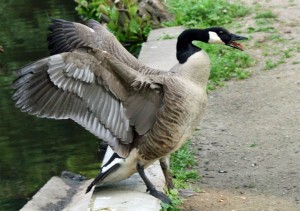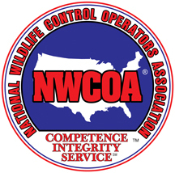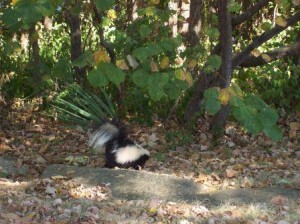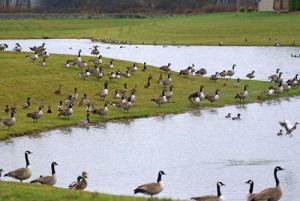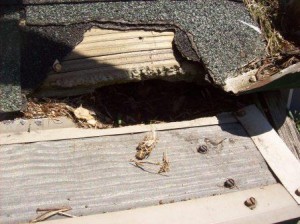Tri-State Wildlife Management is the best choice for professional Canada goose removal and control services in Ohio, Kentucky, and Indiana! 513-853-0037 or 859-635-0037
Canada Goose Removal Cincinnati Tri-State Wildlife Management specializes in Canada goose removal, harassment, and habitat modification. Canada geese, despite their name, extend far beyond Canada, and despite their migratory instincts, not all Canada geese leave their summer home for warmer weather in the colder months. Many Canada geese can be found year-round in the tri-state area due to a comfortable lifestyle acquired from being in close proximity to people. Who needs to fly south when food and warmth are readily available in one place year-round? Residential Canada geese are considered nuisance wildlife when their unpleasant behaviors affect people. First, to complement their migratory instinct, Canada geese are also equipped with a strong homing instinct, meaning they have an unbreakable urge to return to the area that they were hatched and raised. Without intervention, the goose population multiplies rapidly. A large population of geese then translates to large amounts of goose excrement, which is another common complaint against Canada geese. Lastly, Canada geese become very aggressive during nesting, especially males if they feel their nest is threatened.
Canada Goose Control
If unwanted Canada geese are invading the green space of your yard or town, you already know what a nuisance they can be. They are the leading nuisance bird for lakes, parks, golf courses, businesses and homes in close proximity to water. Aside from the overall noise and distraction, unwanted avian guests leave heaps of droppings, feathers and debris, which are unsightly and unsanitary. These droppings are often masses of diseases and can pose serious health risks. In addition to the mess Canada geese become very aggressive during the months of February through June.
Canada Goose Synopsis
Resident Canada geese are difficult to remove. By definition, Canada geese are not classified as pest birds and are afforded protection by federal and state agencies. Nonetheless, Canada geese are increasingly becoming the scourge of suburbia. Country clubs, business parks and community living environments offer pristinely manicured lawns and ponds providing an ideal habitat that effectively modifies their migration cycle. Canada geese are very opportunistic and easily exploit the new “easy living” conditions found in an urban environment. Aesthetic damage to suburban lawns, park, etc., is incalculable. Canada geese are also a health hazard – fouling green spaces, lawns, and ponds.
Breeding and Imprinting
Canada geese have a built-in mechanism that enables them to find their way back to the spot they were hatched. This imprinting creates long-term issues. Habituated geese will return year after year to nest, thus drastically increasing the goose population. Only a well-executed Integrated Management Plan (IMP) can break the cycle and eliminate your goose problem.
Canada Goose Damage and Health Hazards
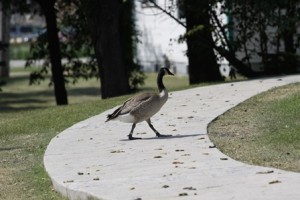
Goose Droppings on Sidewalk
Canada geese are the leading nuisance bird for lakes, parks, golf courses, businesses and homes in close proximity to water. Their acidic droppings corrode many substrates including tar-based roofing materials. Droppings that are allowed to accumulate on roofs damage the material. The life expectancy of a warehouse roof can be cut in half by just a light but continuous application of droppings. Several warehouses every year experience damage from Canada geese. In extreme cases roofs have been known to collapse from standing water when drainage systems are blocked by droppings and feathers. When Canada goose droppings are concentrated, they are unpleasant and a potential health risk. If high Canada goose numbers persist, they have been found to harbor elevated levels of organisms that cause diseases in humans.
Legal Status
Canada geese are protected under the Migratory Bird Treaty Act. Handling and management of Canada geese requires federal permits. The site will also need to be registered in a Nest Destruction Program. As part of the Integrated Management Plan, Tri-State Wildlife Management works with our customers to process the information correctly.
About Us
The courteous staff at Tri-State Wildlife will work for you to provide a cost effective solution to your Canada goose or wildlife intrusion and/or damage issue. As a full service company we will initiate an Integrated Management Plan beginning with an inspection and customer education followed by removal of intrusive Canada geese or wildlife, clean-up, repair/restoration and prevention.
We strive for the most humane and environmentally effective techniques for dealing with Canada geese and wildlife problems. Tri-State Wildlife Management’s use of modern innovative methods provides sound wildlife management services to ensure the protection of our customers’ investments and health.
Tri-State Wildlife Management is a full service company. In addition to your Canada goose issue, TSWM offers bird and wildlife damage repairs, installs custom and standard chimney caps, seals homes and businesses to prevent wildlife from entering, removes bird, bat, and raccoon droppings and debris from attics, installs barrier fencing, removes dead animals and MUCH MORE.
Tri-State Wildlife Management is fully insured, and we stand behind all of our work. Vikki with TSWM is the master NWCOA instructor for the Goose Academy and is also Bird Barrier Certified.
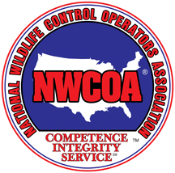
NWCOA
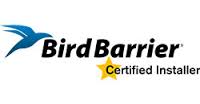
If your home, property, or town has become subject to a Canada goose infestation, or simply a nesting pair, don’t delay, call Tri-State Wildlife Management before the problem gets more serious. Tri-State Wildlife Management is a full service bird control and Canada goose specialist and will help rid your property of any pesky, winged intruders. For Canada goose removal in Cincinnati, call (513) 853-0037!
